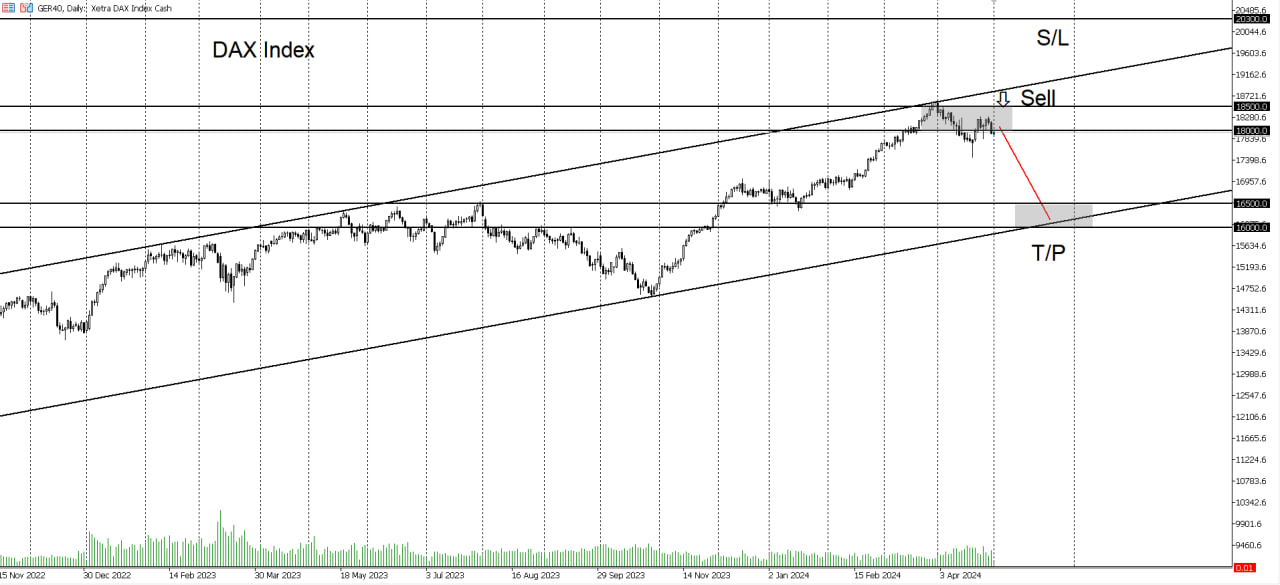Xetra DAX Index
- By date
- Metadoro first
The German DAX stock index reached a historic milestone on April 2, soaring to an all-time high of 18,638 points. However, it subsequently entered a corrective phase, experiencing a decline of 6.3% to 17,450 points by April 19, marking its lowest level since February 27. Despite this setback, the benchmark has managed to partially recover from its losses and encounter resistance within the confines of an ascending channel.
The recent rebound has underscored the resilience of the index, albeit with indications of limited upside potential. As the index encountered resistance, it demonstrated its strength, suggesting that further significant gains may be constrained. Currently, the resistance level has been adjusted to 18,850 points, while the support zone lies within the range of 16,000 to 16,500 points, serving as a noteworthy downside target.
In light of these developments, setting a stop-loss between 19,000 and 20,300 points could be prudent, with a preference for higher levels to mitigate the impact of unexpected volatility.

Xetra DAX Index
The index has some specific features: - It is considered to be an indicator of Germany economic performance as it hosts the largest stocks from different sectors of the national economy. It is one of the most popular indexes to trade;
- German and Eurozone macroeconomic data affect the index, as Germany is the Eurozone’s economic engine. Rising GDP, employment, retail sales, business activity (PMI, ZEW, Ifo business activity indicators) all support the index. If this data is negative, it will likely result in a declining index;
- The DAX 40 index is heavily affected by the performance of the S&P 500 index as the European economy is traditionally and largely exposed to the United States. Its exposure to the Chinese economic performance is also growing, but not to the same extensive extent as that of the U.S.;
- The index is very sensitive to the actions of the European Central Bank (ECB) as the monetary policy of the European monetary regulator directly affects the business performance of German companies. Rising interest rates, borrowing cost, declining monetary supply cuts, corporate profits, and consumer demand affect the index. Monetary tightening puts pressure on the index, while easing monetary policies support the index;
- High inflation in Germany and in the Eurozone also put pressure on the index. If inflation is far above the 2% target, it may lead to additional monetary tightening by the ECB. If inflation is below the target, retail sales are likely to expand, which supports the index;
- DAX is a risky asset and reacts to risk appetite and investors’ sentiment. Positive developments in the global economy and geopolitics support the index, while uncertainties, stress, and geopolitical tensions put pressure on the index;
- The index could be traded via CFDs, futures, or designated ETF’s;
- The index is linked to the European stock market’s opening hours, but futures and CFD trading on the index continues mostly throughout a 24/5 basis, excluding weekends. So, the index may open with a gap if something very important has happened during a weekend.
| Ticker | GER40 |
| Contract value | 10 |
| Maximum leverage | 1:100 |
| Date | Short Swap (%) | Long Swap (%) | No data |
|---|
| Minimum transaction volume | 0.1 lot |
| Maximum transaction volume | 100 lots |
| Hedging margin | 125% |
| USD Exposure | Max Leverage Applied | Floating Margin |
|---|









